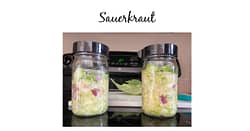
Sauerkraut
Equipment
- 2 32 Ounce Jars
- 2 Fermenting Airlock Lids
- 2 Wide Mouth Glass Fermentation Weights
- 1 Wide Mouth Canning Funnel Optional, but very helpful
Ingredients
- 1 Head Cabbage Chopped, Outer 2-3 leaves Reserved
- 1¼ Tablespoons Redmons Salt Or Another Sea Salt, Must Be Sea Salt
- 1 Medium Onion Diced, optional
Instructions
- Start by carefully removing the outer leaves of the cabbage. You will want to save 1 leaf for each jar you will be using. More leaves if the jar has a larger opening.
- Chop cabbage and place it into your bowl. Add salt.1 Head Cabbage, 1¼ Tablespoons Redmons Salt
- Dice onion into chunky rings, about ¼" wide. Set aside, do not add to your bowl.1 Medium Onion
- Start massaging the cabbage and salt together. You should start to see the liquid coming out of the cabbage- this is what you want!
- Start adding cabbage to your jars, add in onion as you add cabbage. Smash down into the jar using a spoon.
- When you have about 1" of room under the shoulder of the jar (where the jar starts to curve), stop adding cabbage/onion. You need space for the weight!
- Using a reserved cabbage leaf, press it on top of the cabbage/onion. The leaf should fully cover all ingredients in the jar. The leaf helps keep everything submerged in the liquid.
- Add your fermentation weight & fermentation lid. Allow to sit for at least 7 days, longer for more tang.
The nutrition facts provided on this site are only an estimate and are provided for convenience and as a courtesy only. The accuracy of the nutrition facts for any recipe on this site is not guaranteed. It should not be used as a substitute for a professional nutritionist’s advice.
Video
Angie’s Notes
- Add spice to your sauerkraut by adding fresh jalapeno or any other fresh pepper you like!
- Add dill & caraway for a twist on the classic sauerkraut.
- Add an apple for a hint of sweetness.
Like This Homemade Sauerkraut? Share It or Subscribe via email!
Why I Love This Homemade Sauerkraut Recipe
I LOVE sauerkraut when I found out how easy homemade sauerkraut was to make – I immediately tried to make it. This week, I share my take on sauerkraut.
If you haven’t visited my site before, welcome. This week’s post is part of my fermentation series. If you’ve followed me for a while, welcome back. You will notice this recipe is similar to others where it’s easy to “make it your own”.
Continue reading how to make this sauerkraut your own, as well as sauerkraut tips.
Make This Sauerkraut Your Own – Variations For Sauerkraut
When I learned how easy sauerkraut was I was floored. The recipe I saw used fresh jalapenos. I didn’t want to go that route, so instead I used purple onion. The purple onion fermented wonderfully into the cabbage, so much so that it was hard to tell what was onion or cabbage.
Below I have a few other variations that may be tasty.
- chopped apples, radishes or beets
- caraway seeds, about 1 tablespoon per head of cabbage
- ginger if you want a different spicy kick
- dill, parsley, thyme, or rosemary if you are feeling adventurous with your flavor
Personally, I don’t think you can go wrong with any sauerkraut add-ins. Want to know what I wish I knew my first time fermenting? Keep reading!
Homemade Sauerkraut Fermentation Tips
Although this was my first time making sauerkraut, I found a few tips that I wanted to share my homemade sauerkraut recipe with you.
First, be sure all your cabbage is covered with the liquid. If after 24 hours your sauerkraut still isn’t fully submerged, mix up a saltwater solution of 3 cups bottled water and 2 teaspoons Redmon salt. Use enough to fully submerge your cabbage. Save the rest of the solution for other ferments!
Next, don’t worry about getting your cabbage, onions, or other ingredients cut too finely. The smaller your prices are the more risk for mold you have. I kept my pieces fairly large, even after smashing I could still make out the pieces.
Third, watch the temperature. Your ferment will take longer in cooler rooms, and shorter in warmer rooms. One day I was being clever (or so I thought) and put my sauerkraut on a seedling heating mat. My ferment grew cahm yeast. Cahm yeast is harmless but doesn’t taste great. Being new to fermenting, I ended up scrapping that batch and creating a new one. I didn’t like the smell or the off-putting taste.
Finally, have fun! Fermenting is a pretty easy thing that the entire family can do – have fun with it!
Stay tuned next week for the next post in my fermented series.
Subscribe And Be Notified Of Every New Post
Follow Me On Social Media!
Did you find this interesting or useful? You may have noticed my site is ad-free and easier to navigate than most. That’s because I want to provide a better experience when researching gardening or recipes! Please support my site by donating.


